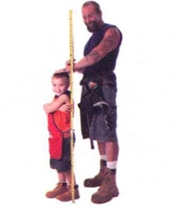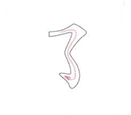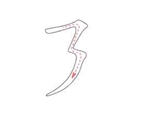- 分角色朗读课文 Role-play the dialogs.
- 根据课文内容回答问题 Answer the questions based on the dialogs.
- 他为什么很少生病? Tā wèi shénme hěn shǎo shēng bìng?
- 他每天几点起床? Tā měi tiān jǐ diǎn qǐ chuáng?
- 她现在身体怎么样? Tā xiànzài shēn tǐ zěnmeyàng?
- 大卫今年多高?多大? Dàwèi jīnnián duō gāo? Duō dà?
- 张老师星期六休息吗? Zhāng lǎoshī xīngqí liù xiūxi ma?
- 用本课新学的语言点和词语描述图片 Describe the pictures using the newly-learned language points and words.

Xiǎolì tiān dōu hěn máng, yě hěn lèi.
小丽____天都很忙,也很累。Tā měi tiān zǎoshang chūqu____, shēn tǐ hěn hǎo.
他每天早上出去____,身体很好。
Wáng yīshēng de érzi duō____?
王医生的儿子多____?Wǒ tīngshuō Ānnī____le, wǒ xiǎng qù kànkan tā.
我听说安妮____了,我想去看看她。

(1)中轻重格式 “Medium-stressed + Light + Stressed” Structure
大多数三音节词属于 “中轻重” 格式,即第一个音节为中音,音长次长;第二个音节为轻音,音长最短;第三个音节为重音,音长最长。例如:
Most trisyllabic words fall into this type of structure, in which the first syllable is medium-stressed and medium in length, the second syllable is light and short, and the third syllable is stressed and long. For example:
- shōuyīnjī 收音机
- Xīnjiāpō 新加坡
- Hǎoláiwù 好莱坞
- diànshìjù 电视剧
(2)中重轻格式 “Medium-stressed + Stressed + Light” Structure
三音节词属于“中重轻”格式的数量不多,即第二个音节为重音,音长最长;第一个音节为中音,音长中;第三个音节为轻音,音长最短。例如:
There are not many trisyllabic words of this kind, in which the second syllable is stressed and long, the first syllable medium-stressed and medium in length, and the third syllable light and short. For example:
胡萝卜
没关系
老狐狸
毛孩子
(3)重轻轻格式 “Stressed + Light + Light” Structure
三音节词语属于“重轻轻”格式的很少,多为口语词,它的第一个音节为重音,第二、三个音节都为轻音。例如:
There are even fewer trisyllabic words of this structure, in which the first syllable is stressed and the other two are light in tone. Most of these words are colloquial. For example:
什么的
怪不得
姑娘家
好 着 呢
汉字 1 汉字的笔画(8): 3, 3
Strokes of Chinese Characters (8): 3, 3
| 笔画名称 Stroke |
运笔方向 Direction |
例字 Example Characters |
|---|---|---|
| 横撇弯钩 hénɡpiēwāngōu Horizontal-Left Falling-Curved Hook |
 |
队 duì (team) 阵 zhèn (battle array) |
| 横折折撇 hénɡzhézhépiě Horizontal-Double-Turning-Left Falling |
 |
及 jí (to reach; and) 级 jí (level, grade) |
2. 认识独体字 Single-Component Characters
(1)“生”,字形像地面上长出了一株嫩苗。本义是“生长”、“长出”,现在意思很多,如“生病”、“生活”。
The original form of “生” looks like a young seedling sprouting from the earth. Its original meaning is “to germinate and grow”. Now it has various meanings, such as “to get (ill)” and “to live”.

(2)“高”,字形像一座高高的楼阁,表示“高”的意思。
The original form of “高” looks like a tall pavilion. It means “tall”.

3. 汉字偏旁 “⺮” 和 “欠” Chinese Radicals: “⺮” and “欠”
| 偏旁 Radical |
解释 Explanation |
例字 Example Characters |
|---|---|---|
| ⺮ | 竹字头,一般和竹子有关。 The radical “⺮” is usually related to bamboo. |
篮 lán (basket) 笔 bǐ (pen) |
| 欠 | 欠字旁,一般和嘴的活动有关。 The radical “欠” is usually related to movements of the mouth. |
歌 gē (song) 吹 chuī (to blow) |
1 运用活动 Application
双人活动 Pair Work
两人一组,询问对方一天的生活。例如:
Work in pairs and ask about your partner’s daily routines. For example:
Nǐ měi tiān jǐ diǎn chī zǎofàn?
例如: A: 你 每 天 几 点 吃 早饭?
B: Wǒ……
Nǐ měi tiān shénme shíhòu yùndòng?
A: 你 每 天 什 么 时 候 运 动?
B: ……
2 小组活动 Group Work
3-4人一组,互相询问对方的基本信息和运动情况。每组请一位同学报告情况。
Work in groups of 3-4. Ask the basic information about your group members and the sports they do. Each group chooses a member to make a report.
Nǐ duō dà?
例如: A: 你 多 大?
B: Wǒ……
B: 我……
Nǐ duō gāo?
A: 你 多 高?
B: ……
Nǐ měi tiān zuò shénme yùndòng?
A: 你 每 天 做 什 么 运 动?
B: ……
| 姓名 Name |
年龄 Age |
身高 Height |
运动 Sports |
|---|---|---|---|
| 小王 Xiǎo Wáng |
18岁 shíbā suì |
1米75 yī mǐ qī wǔ |
每天早上跑步,每个星期六踢足球。 Měi tiān zǎoshang pǎo bù, měi ge xīngqī liù tī zúqiú. |

Comments